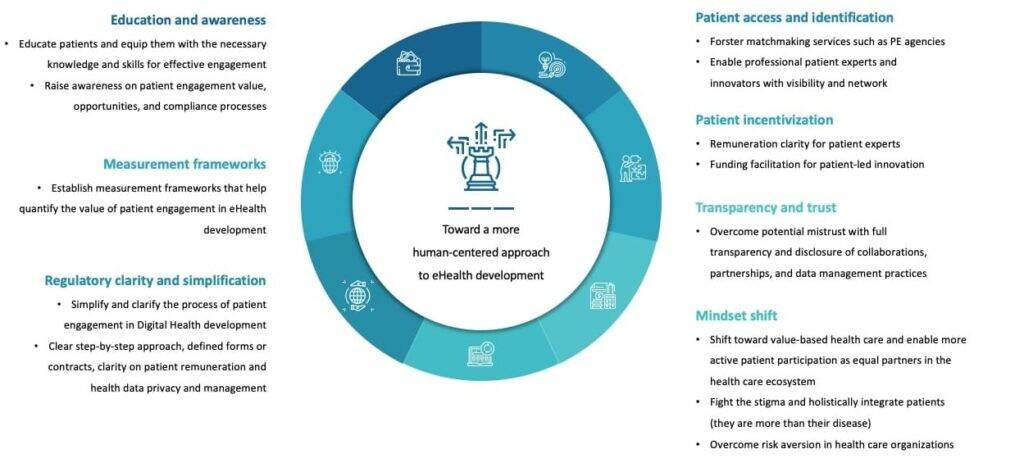A study, "From Testers to Cocreators—the Value of and Approaches to Successful Patient Engagement in the Development of eHealth Solutions", published in JMIR Human Factors, interviewed 20 top industry experts in 6 countries across Europe to better understand the challenges and opportunities in the inclusion of people who are patients in the development of eHealth technologies and ideas on how to overcome the identified gaps. The study was funded by Innosuisse, the Swiss Innovation Agency, and conducted by researchers from the University of Applied Sciences Northwestern Switzerland in collaboration with the practice partner PersonalPulse GmbH.
Tremendous potential value, but not without barriers
The study showed that truly engaging people who are patients as equal partners in eHealth development could bring different types of value. One of the most prominent is the ability to identify unmet needs, better usability and desirability of the tools, which typically result in better adoption and stickiness, and a more holistic view that better fits into the overall patient journey. It also fosters trust and advocacy. The tools' better adoption and stickiness imply better health outcomes mainly because of adherence, which enables the least technically capable patients to still use those tools, resulting in better health equity and access. It also gives a sense of purpose to the developing teams as they can relate better to the patient's needs and pain points.
There are, however, some significant barriers to overcome. Compliance is the most prominent barrier, with participants mentioning the complexity of regulatory processes as a critical hurdle. However, some participants pointed out that this may also be partly a perception issue in that some stakeholders may perceive compliance as more complex than it is. Compliantly compensating patients for their engagement was also perceived as a challenge, and lack of process clarity was also raised as an issue, especially for smaller eHealth providers that may not have the resources or in-house knowledge about relevant regulatory processes.
 Source: Jacob C, Bourke S, Heuss S. From Testers to Cocreators—the Value of and Approaches to Successful Patient Engagement in the Development of eHealth Solutions: Qualitative Expert Interview Study. JMIR Hum Factors 2022;9(4):e41481. DOI: 10.2196/41481
Source: Jacob C, Bourke S, Heuss S. From Testers to Cocreators—the Value of and Approaches to Successful Patient Engagement in the Development of eHealth Solutions: Qualitative Expert Interview Study. JMIR Hum Factors 2022;9(4):e41481. DOI: 10.2196/41481
Education and awareness are key to improving patient engagementSome patient-related factors may also make it difficult to engage patients in eHealth development. Specifically, not only are patient identification and patient access a key hurdle, but also some health-related constraints may render it difficult for some patients to engage, or some patients lack the needed skills to engage efficiently. Power dynamics in the healthcare sector may also hinder patient engagement. Patients not being seen as equal partners, conflict of interests among the stakeholders, the economic model that gives more power to the payers, patients not being given a safe space to express their needs and pain points, and the lack of decision power in many cases can negatively impact patients' involvement. Other barriers included patient engagement being considered a marketing activity or lip service by some stakeholders, the lack of clarity on the value that patient engagement may bring, resource constraints, mistrust between patients and other stakeholders, and sometimes a mere inflexibility of some eHealth providers. From testers to co-creators: overcoming the gaps in the current patient engagement approaches "Our aim is to help guide the relevant stakeholders to successfully engage patients as equal partners and co-creators in all phases of the design rather than mere testers of preplanned prototypes," says the first author of the study Christine Jacob, lecturer and health tech researcher at the university of applied sciences Northwestern Switzerland, and founder of Digi-Bridges GmbH. Overcoming the identified barriers to patient engagement in eHealth development is a crucial step toward achieving this goal. This shift toward more patient-driven eHealth development requires consolidated efforts from all stakeholders in the complex healthcare ecosystem. Education and awareness are key to improving patient engagement. On the one hand, it involves educating patients and equipping them with the necessary knowledge and skills for effective engagement and contribution. On the other hand, it is crucial to raise awareness of the value that patient engagement can bring, provide platforms that may help promote patient engagement opportunities, and provide more information about relevant compliance processes. There is also a need for measurement frameworks that can help quantify the impact of patient engagement to shed light on the business case for it and overcome the value perception barrier. Regulatory clarity and simplification would also play a central role in facilitating patient engagement. A clear step-by-step approach, templates for agreements and contracts, clarity on patient remuneration, and health data privacy and management would encourage the relevant stakeholders to engage patients compliantly without being too worried about compliance risks. Barriers such as patient access and identification could be overcome by working with engagement partners and promoting novel approaches to empower professional patient experts and innovators with visibility and networks. The rise of matchmaking services can also play a positive role in overcoming these barriers; patient engagement agencies that focus on identifying and engaging with relevant patient experts to match them with suitable patient engagement opportunities are a good example. Equally, we can overcome potential mistrust between different stakeholders with complete transparency, disclosure of collaborations and partnerships, and more clarity on data management practices. "Our research is one more important step in taking the people who are patients out of the centre and empowering them to move to the position of partner," says Steve Bourke, practice partner PersonalPulse. This change would also require a mindset shift toward more value-based health care, would help overcome the current imbalance in power dynamics and reinforce a more active role for patients, and to fight the stigma around disease and being a patient, to empower patients, and to encourage them to speak up.
 Source: Jacob C, Bourke S, Heuss S. From Testers to Cocreators—the Value of and Approaches to Successful Patient Engagement in the Development of eHealth Solutions: Qualitative Expert Interview Study. JMIR Hum Factors 2022;9(4):e41481. DOI: 10.2196/41481
Source: Jacob C, Bourke S, Heuss S. From Testers to Cocreators—the Value of and Approaches to Successful Patient Engagement in the Development of eHealth Solutions: Qualitative Expert Interview Study. JMIR Hum Factors 2022;9(4):e41481. DOI: 10.2196/41481






